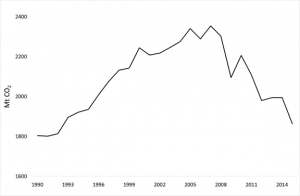New state-by-state research shows significant reductions across the country from 2005-2015
Decarbonizing the power sector in the United States will be critical to achieving the goal of a 100% clean economy by 2050 – especially since reaching “net-zero” greenhouse gas emissions across the economy means that other energy-using sectors such as buildings and transport will increasingly need to be electrified, switching away from direct fossil fuel use and relying on low-carbon electricity instead. Demand for electricity is therefore very likely to grow in the future – which makes it critical that its CO2 emissions sharply decrease through the accelerated deployment of low carbon technologies, such as wind and solar power, in the decades ahead.
For now, US power sector CO2 emissions appear to have turned a corner. While CO2 emissions from the U.S. power sector increased between 1990 and 2005, they peaked shortly thereafter, and then decreased to the point that by 2015, they had fallen by 20% (or 480 million metric tonnes CO2) compared to 2005.
In recently published research, my co-authors and I wanted to understand the drivers behind the drastic fall in the country’s—and individual states’–power sector CO2 emissions, and in particular the role that low carbon technologies such as wind and solar power have already played in reducing US power sector CO2 emissions. Our analysis, published in Environmental Research Letters used an approach called index decomposition analysis and found that natural gas substituting for coal and petroleum coupled with large increases in renewable energy generation—primarily wind—were responsible for 60% and 30%, respectively, of the decline in CO2 emissions from the US power sector between 2005 and 2015.
Renewable growth in red states
Most of the emissions reductions driven by renewable energy growth came from Texas and states in the Midwest — Iowa, Kansas, Illinois and Oklahoma. While many of these states are not necessarily known for supporting aggressive climate policies, the combination of federal tax credits, state energy policies, decreasing costs of renewables and windy conditions appears to have provided powerful support for renewable energy deployment.
Texas, in particular, is an interesting case. In 2005, it was the leading emitter of U.S. power sector CO2 emissions across the country. But by 2015, its gross reductions from wind energy totaled 27 million metric tons, or more than 5% of the total net US reduction in power sector CO2 emissions since 2005 (i.e., a sixth of the total US reduction attributed to renewables). The state achieved its final renewable portfolio standard (RPS) target in 2008—seven years ahead of its 2015 goal. In addition to reduced costs of turbine technologies, federal tax credits and positive wind conditions also likely played a role in wind’s growth.
Wind generation in Texas, Iowa, Kansas, Illinois and Oklahoma together contributed half of the renewables-related emission reductions (70Mt or 3%-points out of the 20% reduction in US power sector CO2 emissions since 2005).
Over the same period, many states that had relied heavily on coal like Pennsylvania, Georgia, Alabama and Florida, reduced emissions by substituting natural gas for coal in electricity generation. While that prompted a decline in CO2 emissions, it’s important to note that while natural gas emits less CO2 emissions than coal and petroleum when producing electricity it is still a source of CO2 emissions and can only take us so far in decarbonizing the power sector. In addition, methane leakage across the supply chain remains a significant issue–and is not accounted for in this analysis, meaning the overall net greenhouse gas benefit from this natural gas expansion was–potentially significantly—lower.
Need for new policy
While there are positive signs in the power sector—the cost of renewables continues to decline and a growing number of states are taking crucial action to cut CO2 emissions, these trends as well as the specific factors identified in this analysis cannot be relied upon to achieve the deep emissions reductions needed in the decades ahead.
U.S. power sector CO2 emissions are projected to remain relatively flat over the next decade and rise slowly after that, absent new policies. This is particularly significant given that, much of the decarbonization of other sectors such as buildings and transportation will need to rely heavily on electrification.
Ultimately, new policy interventions are necessary, including strong limits on climate pollution – not only in the power sector, but across the entire economy to drive reductions at the pace and scale needed for the US to be 100% clean no later than 2050.










